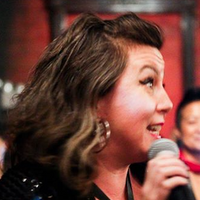On storytelling as activism
Prelude
Tatyana Fazlalizadeh is a Black/Iranian portrait artist and activist who has posted her “Stop Telling Women to Smile” series on walls around the world—some of it funded by a 2013 Kickstarter project—and published a book by the same name as an examination of issues of street harassment. She was the art consultant for Spike Lee’s Netflix series She’s Gotta Have It and the inaugural Public Artist in Residence for the New York City Commission on Human Rights. She recently launched BLK Paper, an online resource for downloading free racial justice posters made by Black artists.
Tatyana is one of the participating artists in People for the American Way’s ENOUGH campaign. This fall, the organization hopes to place billboards from more than a dozen American artists in swing states that went to Trump last election. See their Kickstarter project page HERE
Conversation
On storytelling as activism
Visual artist Tatyana Fazlalizadeh on reclaiming space, telling your truest stories, and the surprise attack of street art.
As told to Katheryn Thayer, 3040 words.
Tags: Art, Activism, Inspiration, Politics, Identity.
What do you see as street art’s ability to shift power dynamics in public spaces? How have you seen this play out with the work that you’ve done?
One thing that street art does is give groups and individuals a voice. I think we can see very early on when it comes to graffiti and tagging: Young Black and Brown folks going out and tagging their names on the street as simply a way of claiming a space or reclaiming a space. I think there’s a lot of power in that, in that it gives some sense of empowerment to an individual in a group that’s often disempowered.
With my work in particular, I’m thinking about how women, femmes, and non-binary people are treated in the street, and how a lot of the times it feels like we are trespassing onto someone else’s space. The public space can be a very volatile space for us, a very dangerous space for us for many different reasons. The work itself gives us a voice, gives us space, gives us visibility in that environment where we are often disempowered.
What public art does is it gives people agency. It gives people a chance to reclaim something as their own. It gives people ownership over art in an environment that is their own. It doesn’t have to be a gallery. It doesn’t have to be a museum.
What’s the relationship between your identities as an artist and activist? How do you see those intertwining?
I haven’t always considered myself an activist. I think it’s a title that people assigned to me and I don’t shy away from, because when you put up a piece of work in the street, it’s an activity. You are taking an action against something, and it’s a more visible activity than someone who paints or does design in a more traditional sense.
What I’m doing is creating work that is useful to people, that’s useful to movements, and useful to shifting culture toward treating people better in public spaces. And so, because of that, if I’m claimed as an activist, then I’m okay with that. But my work is really mostly about telling our stories and reclaiming our voice and reclaiming our space.
And that’s why street art is not just about the work itself. The site of the work is very important. The process of getting to the work is very important. For me, I interview people. I engage with communities. I engage with individuals, and that process is just as crucial as the final piece itself. For me, that’s where the activism part comes in. I’m talking to people and telling their stories. I’m using the work as a tool in a way.
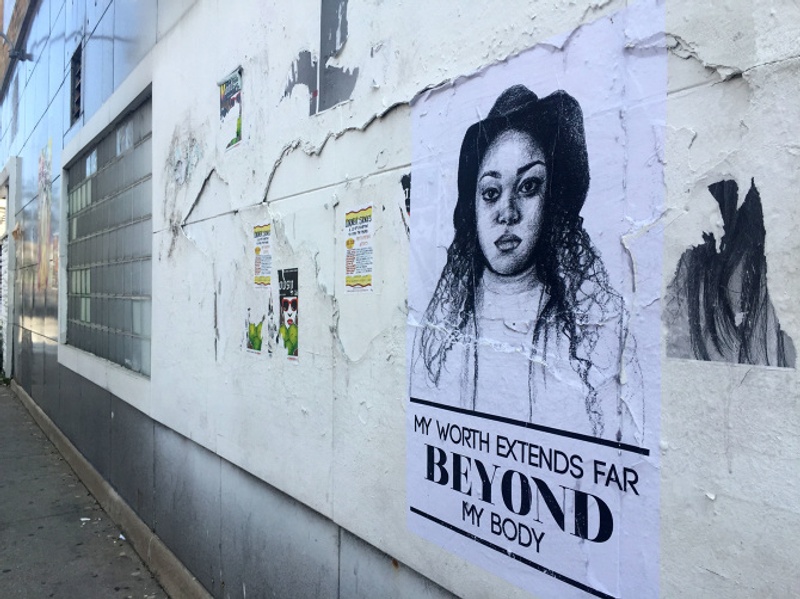
Image courtesy of Tatyana Fazlalizadeh
What are the interviews like? Did that make you see street harassment in a different way or shape the work in ways you weren’t expecting?
Yeah. I have learned so much about other folks’ experiences with street harassment through the process of interviewing. That’s why the interviews—engaging with people—are so important to me. Because as an artist, I also need to be educated on how other people experience the world and how they experience the streets. I have my own personal experiences with street harassment and the layering of oppressions within that—sexism, racism, all of these things in the public space—but those are just my experiences. So it’s important for me—in order to be able to tell these stories, in order to be able to talk about street harassment and the different ways that it happens—to hear as many stories as possible. And I encourage people who view my work to take notice of that, to take notice of the fact that I am talking to a bunch of different people, because I want to complicate the idea of street harassment, and I want people to have a better understanding of the overwhelming variety of ways it affects different people. It’s important for me to understand that so that I’m able to reflect it back out to the public.
Your work is asking women to open up about trauma and the burdens that we’re so often quiet about, and it reminds me of the Muriel Rukeyser line, “What would happen if one woman told the truth about her life?” And her answer is, “The world would split open.” How would you answer that question?
I think if one woman told the truth about herself, it would allow every other woman to tell the truth about themselves. That’s the main thing that I’ve learned from the work that I do: When you tell your story—your personal story, publicly—it becomes a collective story. It’s not just yours. You find that so many other women experienced the same thing.
When you tell the truth about yourself and the truth about your life, it gives other women permission to do the same thing. And if we all have permission to tell our stories and to tell our truths, then there’s really no stopping that. Then it becomes undeniable. You can’t ignore it anymore.
So often when we tell our stories, we’re made to feel like we have to prove it. Our stories aren’t believed or listened to. But when so many of us do it, it becomes increasingly harder to ignore us. What’s great about the last few years is we’ve seen the rush of women simply telling their stories.
For other artists who want to engage with this type of work, have there been some things you’ve learned along the way about sharing other people’s stories, communal stories—ways of doing it respectfully and effectively?
That’s something that I’m always thinking about, “Am I being responsible?” There’s a level of trust that happens when people tell you their story and allow you to portray their likeness and tell their story. There has to be some trust there.
I guess my advice would be to listen as closely as possible, be very honest, and try to create some space for them to be able to tell their own story.
It’s one thing to be an artist and to reflect other people’s stories and experiences, but if you can, at the same time, create some type of system that allows people to tell their own stories and gives them some power in that process. It’s something that I’m figuring out how to do more of in my own work. So if I can create a space for a young, queer person with disabilities to tell their own stories, then I’d rather do that than try to tell their story myself. Sometimes you just have to take a step back and allow people to tell their own stories.
I think that’s especially true when we think about race. We think about White folks selling Black or Brown people’s stories. In what ways can you take a step back and allow this person or group to tell their own stories? How can you just be there as a resource, as help? This is why I’m very specific about doing work that’s about Black people, queer people, women, and femmes, because those are my communities. Those are my groups. I feel more comfortable telling those stories than stepping in and trying to sell someone else’s.
You also made a book about this. How did that form factor help you tell the stories in a different way? How is it different from the type of encounter you have with public art?
It opens up this well-rounded look at street harassment as a whole, as opposed to the short, isolated pieces that you see on the street. You get a really good understanding of how street harassment works. The book is a very in-depth look at street harassment from my own experience to the experiences of the 10 people that I feature in the book.
The book allowed me to really say, “This is the process. This is a very long process. These are the stories. This is why it’s important to truly understand how street harassment works, how people experience street harassment based on their different identities,” and to really show that in an in-depth way.
Given the plurality of experiences that make this up, how did you distill all of it into this banner of “Stop Telling Women to Smile”? Why did that feel like the phrase that sums it up?
The title is a way to bring people into the work and make them question street harassment, make them take a good look at these normalized instances of harassment that we don’t always identify as harassment. If I were to call the project “Don’t Harass Women in the Street,” then people would just say, “Well, yeah, of course. Don’t harass women in the street.” But to point out a particular instance that we’re all very, very familiar with—men, women, and non-binary folks—but maybe not everyone understands as harassment, is I think smarter than using really broad terms.
Even a lot of women that I’ve talked to have said that they always thought something was a little weird or off about people telling them to smile, but they couldn’t place why. And that’s the point, right? The project opens up the conversation about street harassment and the spectrum of street harassment: It can be an annoyance or it can be physical assault or death. People are killed on the street in the context of street harassment. And so I really wanted to title it something that pinpointed these small instances we’re all very familiar with as a way to open up the conversation.
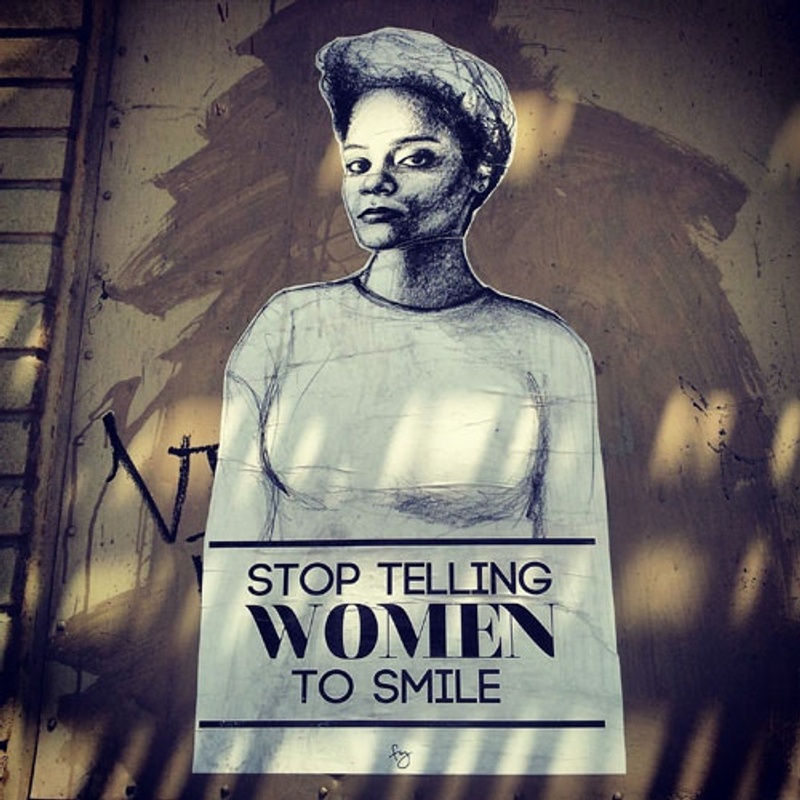
Image courtesy of Tatyana Fazlalizadeh
Do you see men as being a target audience, like that you want to convert them and bring them into this conversation?
Yeah, I want them to be in the room and part of it, but in a way that involves listening more than speaking. I want men to hear the conversation as opposed to offering up their opinions on it, which is what I feel like has often happened over the years with this work: Men tend to want to center their experience, center their ideas of what street harassment is as opposed to just taking a step back, listening, and hearing what women experience, believing us. Then I hope they take that information and go do something with their behavior, their friends’ behavior. That’s how I see their role.
In my book there is a chapter dedicated to men because they should be there, they should be reading this. They’re the main ones who should be reading this book and taking in this information. It’s not asking them what their opinion is on street harassment. It’s telling them, “This is what happens to us. This is what you can do about it.” If there’s a conversation that should be had, it’s between them and other men. So often men are just performing for one another, or performing some type of masculinity that they’ve been taught. How do they break that down? How do they unlearn that? That’s some stuff that I think needs to be discussed within their own group, but it definitely starts with them hearing and seeing and believing us.
This seems like a great case to be doing things as print ephemera, as public art, and not on the internet, where there’s more room for men’s responses. How do you feel print rather than digital media helps center women, minorities, queer femmes, the people who usually do not get to be the loudest voice in the room?
Well, I think it’s about the environment. This work is printed and put out in the street because that’s the environment where this issue happens, in the street. If I was talking about online harassment, then perhaps online would be the space for that type of work, but I needed the people who perpetrate street harassment to see it in the environment where they perpetrate it. If you were someone who experiences street harassment and you walk by one of these pieces in the street, I think it comforts you more, in a way, than it would if you saw it on the internet. Because that’s where it’s happening. The environment is just as much as part of, is crucial to the work as much as the work itself.
The act of it is important. The act of going out in the street and putting a piece of work on the wall is taking back space, literally taking back space as a woman. I belong here. My face belongs here. My words belong here.
And not everybody is online. Not everybody is on the internet. Not everybody is on social media and those who are aren’t necessarily looking for some type of activist message, right? But if you’re walking down the street and you just come across one of these pieces, it confronts you in a way that’s right there in real life with you. It’s completely different than something that you just see when you’re scrolling.
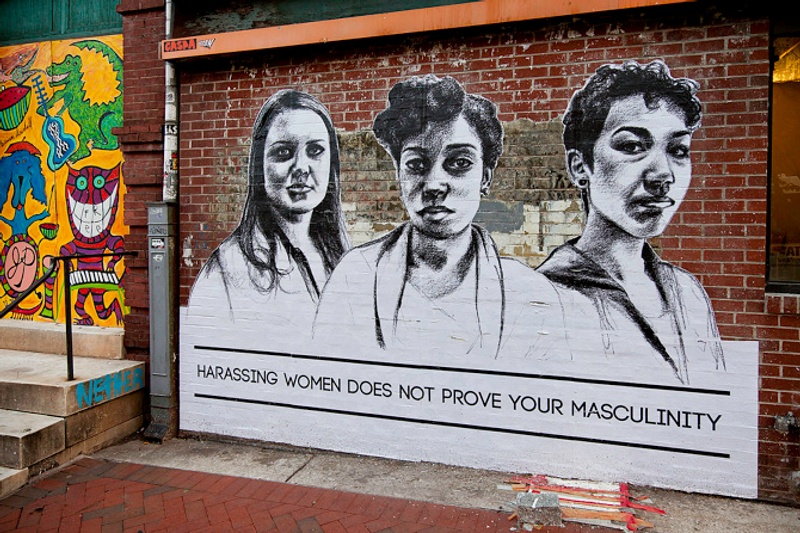
Image courtesy of Tatyana Fazlalizadeh
What have been some of your experiences with putting up the art physically? Is it the act of doing it that’s important to you, or have you had some interactions that shaped the work while it’s happening?
I haven’t really had any interactions when I’ve put up the work. I just like to get it up and get out of there. But the act of putting it up is great for me. The act of simply seeing them in the streets is great for me as well. People have access to this work—there are pieces that you can download from the internet and put up yourself. I have come across pieces in the street that I didn’t even put up myself, that I didn’t know were there, and been like, “Oh.” And so when that happens, it’s like I’m experiencing the work as someone else, as someone who isn’t the artist, because I didn’t know that the work was there. I get to experience what I hope the work is doing for others, which is catching people off-guard. And if you’re a woman, it hopefully catches you in a way that feels like you have a defense for yourself, like you have some type of solidarity out there.
What’s important about that element of surprise? How does that make it more powerful?
For those of us who experience street harassment very often, we come to expect it, but you aren’t necessarily prepared for it. You’re often just walking, living your life, going about your day, and then someone says something rude or crude to you or comments on your body, and it hits you in this way that can really have an effect on you. It can have an emotional, mental effect on you. It’s something that you can carry with you for the rest of your day. These things really interrupt your mental and emotional space.
So hopefully the work does the opposite. You aren’t necessarily expecting to see this work, but if you turn a corner and see a piece on the wall that’s speaking to your experience, that relates to you, that is speaking back to harassers in a way that sometimes you probably can’t, then my hope is that coming across that unexpectedly provides you with some sense of comfort.
That’s why the work is mostly for women and femmes—people who experience street harassment. The text on the piece is directed towards men and harassers, but the work is really “for” us. It’s a way to speak up for us when we can’t speak up for ourselves. And so that’s why the element of surprise is important.
That’s what street art does—it becomes a part of the environment. And it’s important to have something that’s a part of the environment that is empowering women and reflecting our voices and our spaces, to make us a part of the environment in a space where so often it feels like we’re trespassing and we don’t belong there. This work physically makes us a part of it.
What advice do you have for creators who want to dip into either activist art or street art or both for the first time? What are some things you’ve learned?
Be very clear about what it is that you’re saying, what it is that you are doing, and why you are doing it. I think over the past few years, I’ve noticed that people have started to use street art as a marketing tool for their artwork. People who wouldn’t necessarily put artwork in the street are now putting it out on the street because they noticed that people will take pictures of it and they’ll get big online presences. But for me, I think it is important that the site of the work is appropriate and makes sense for the artwork. So think about why you’re doing it. What is the intention there? Where are you putting it up? How is the community and the neighborhood going to respond to that?
It’s about being intentional. And tell your story. Start with yourself because that’s the easiest way to be truthful. Be very honest and understand the importance of telling your story—especially for women, Black and Brown people, queer people—because nobody else is going to do it. So start there: be honest about it, be intentional about it, and I think you’ll be OK.
Five places in NYC where you can see Tatyana Fazlalizadeh’s work:
Hancock and Bedford in Brooklyn.
134th and Frederick Douglass at PS 092 in Harlem.
West 56th St and 12th Ave in Manhattan.
360 E 161st St at The Bronx Defenders.
Daniel M. O’Connell Playground in St. Albans, Queens.
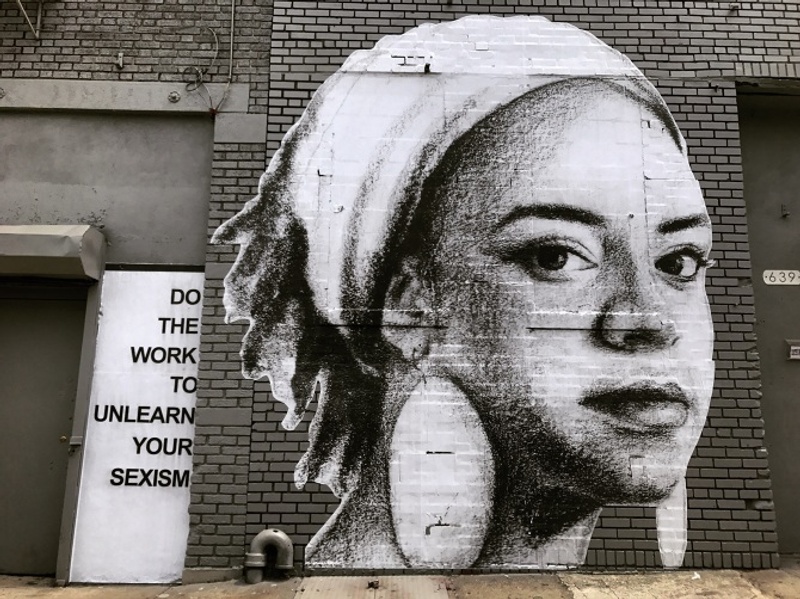
Image courtesy of Tatyana Fazlalizadeh
- Name
- Tatyana Fazlalizadeh
- Vocation
- Artist and activist
Some Things
Pagination
